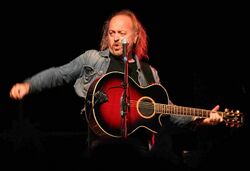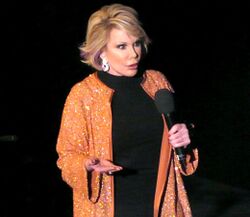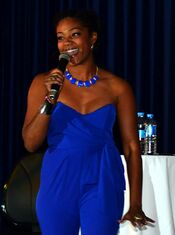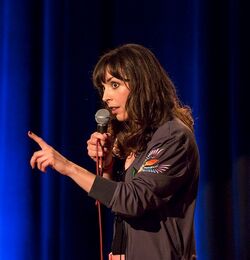Social:Stand-up comedy
Stand-up comedy is a comedy performance to a live audience in which the performer, known as a comedian, comic or "stand-up", stands on a stage and delivers various humorous and satirical monologues ,and occasionally also physical acts, typically involving no other props except a microphone and a stool. The performance is usually a rhetorical sketch with rehearsed scripts, but many comics employ live crowd interaction as part of their routine.
Stand-up comedy consists of one-liners, stories, observations or shticks that may incorporate props, music, magic tricks, impressions or ventriloquism. It can be performed almost anywhere including comedy clubs, comedy festivals, bars, nightclubs, colleges or theaters, however, it is best suited to the controlled environment of a purpose-built comedy club.[citation needed][1]
History
Stand-up as a Western art form has its roots in the stump speech of American minstrel shows, which featured an actor in blackface delivering nonsensical monologue to the audience. While the intention of stump speeches was to mock African Americans, they also occasionally contained political and social satire. The minstrel show would later influence theatrical traditions of the late 19th and early 20th centuries, such as vaudeville and burlesque.[2]
Charles Farrar Browne (April 26, 1834 – March 6, 1867) was an American humor writer, better known under his nom de plume, Artemus Ward. This character was portrayed as an illiterate rube with "Yankee common sense", also played by Browne in public performances. He is considered to be America's first stand-up comedian.
The first documented use of "stand-up" as a term was in The Stage in 1911, detailing a woman named Nellie Perrier delivering 'stand-up comic ditties in a chic and charming manner', though this was used to describe a performance of comedy songs rather than stand-up comedy in its true modern form.[3]
In The Yorkshire Evening Post on November 10, 1917, the "Stage Gossip" column described the career of a comedian named Finlay Dunn. The article stated that Dunn was "what he calls 'a stand-up comedian'" during the latter part of the 19th century, although the term may have been used retrospectively.[4]
Genres
Stand-up has multiple genres and styles with their own formats. Common ones include:
- Alternative: Intended to counter the established figures of mainstream comedy.
- Anecdotal comedy: Storytelling using exaggeration and humor [5]
- Character: A fictional persona created by the performer.
- Deadpan: AKA dry humor, or dry-wit humor is the deliberate display of emotional neutrality or no emotion, commonly as a form of comedic delivery to contrast with the ridiculousness or absurdity of the subject matter.
- Insult: Consists mainly of offensive insults, usually directed at the audience or other performers.
- Musical: Humorous songs or musical parody sometimes without lyrics.
- Observational: Conversation on the absurdities of everyday life.[6]
- Satire: Ridicule of celebrity, political figures, the establishment, religion or ideology[citation needed]
- Topical: Framed around a specific topic related to current events or dealing with issues that are important or popular at the current time
- Wordplay comedy: tends to involve the use of tactics like puns, double entendre, and rhymes to entertain audiences. Thus, delivery tends to be filled with many one-liners.[7]
Stand up performances
Opener, Feature and Headliner
The host, compere or emcee "warms up" the audience and introduces the other performers. This is followed by the opener, the feature, then the headliner. The host may also double as an opener for smaller shows.[8] Proven comics can get regular bookings for club chains and comedy venues. Jobbing stand-ups may perform sets at two or more venues on the same day.[citation needed]
Open Mic
Club and small venues often run open mic events; these slots may be booked in advance or left for walk-ins. Comedians use open mics to work on material or to show off their skills to get an opener slot.[9] "Bringer shows" are shows that require amateur performers to bring a specified number of paying guests with them in order to receive stage time.[citation needed]
Festivals
As well as being a mainstay of the comedy circuit, festivals often also showcase up and coming acts, with promoters and agents using the festivals to seek out new talent.[10]
TV specials and albums
Experienced comics with a following may produce a television special or a comedy album. It may be recorded on tour or at a show advertised and performed specifically for the purpose. A TV special originally released on television, video on demand or film theaters may be re-released as an album on audio CD, LP record or audio streaming. A "half-hour special" is typically between 20 to 35 minutes in runtime without commercial breaks and an "hour-long special" is typically between 40 to 65 minutes without commercial breaks.[11]
Comedy Set
Routine
Stand-up comedians define their craft through the development of routines, constructed and refined by jokes and interconnected "bits." These bits form an interwoven narrative, leading to the "closer," the final joke that ties the show's themes together for a satisfying conclusion.
Most jokes are the juxtaposition of two incongruous things and are made up of the premise, set-up, and punchline, often adding a twist, topper or tagline for an intensified or extra laugh. Delivery relies on the use of intonation, inflection, attitude and timing or other stylistic devices such as the rule of three, idioms, archetypes or wordplay.[12][13] Another popular joke structure is the paraprosdokian, a surprising punchline that changes the context or meaning of the setup.[14]
In order to falsely frame their stories as true or to free themselves of responsibility for breaking social conventions, comedians can use the jester's privilege, the right to discuss and mock anything freely without being punished.[15][16] Social commentators have referred to the concepts of "punching up" and "punching down" in attempting to describe who should be the "butt of the joke". This carries the assumption that, relative to the comedian's own socio-political identity, comedy should "punch up" at the rich and powerful without "punching down" at those who are marginalized and less fortunate.[17][18] Many comedians have criticized the cultural rhetoric concerning "punching up" and "punching down", including Colin Quinn, who described the terms as a product of activism and "not created by humorous people."[19]
Joke Theft
Appropriation and plagiarism are considered "social crimes" by most stand-ups. There have been several high-profile accusations of joke theft, some ending in lawsuits for copyright infringement. Those accused will sometimes claim cryptomnesia or parallel thinking,[20][21] but it is difficult to successfully sue for joke theft regardless due to the idea–expression distinction.[22]
Audiences
According to Anna Spagnolli, stand-up comedy audiences "are both 'co-constructors of the situation' and 'co-responsible for it' ".[23]
In stand-up comedy, an unspoken contract with the audience allows for the exploration of unexpected, controversial, or scandalous subjects. The reception of a joke, whether met with laughter or disapproval, hinges on the audience's understanding of the premise and appreciation of the punchline.
Stand-up comedy, distinct from traditional performing arts, features a lone comedian directly engaging the audience. The success hinges on creating spontaneity, fostering intimacy, and deterring heckling.
Part of the appeal of stand up is in appreciation of the skill of the performer, most people find the idea of standing on stage extremely daunting; research on the subject has consistently found that the fear of public speaking is more intense than the fear of dying.[24][25]
The audience is integral to live comedy, both as a foil to the comedian and as a contributing factor to the overall experience. The use of canned laughter in television comedy reveals this, with shows often seeming "dry" or dull without it. Shows may be filmed in front of a live audience for the same reason.[26]
Terms
- Beat
- A pause specifically to create comic timing.
- Bit
- A section within a comedy show or routine.
- Bombing
- Failing to get laughs.
- Callback
- A reference to a joke earlier in the set.
- Chewing the scenery
- Being overly theatrical or "trying too hard" to get a laugh, especially when failing.
- Chi-chi room
- The ritzy room of a nightclub or a comedy club with niche performances.[27]
- Clapter
- When the audience cheers or applauds an opinion that they agree with, but which is not funny enough for them to laugh at. Coined by Seth Meyers.[28]
- Corpsing or breaking
- When the comedian laughs unintentionally during a portion of the show in which they are supposed to keep a straight face.
- Crowd work
- Talking directly with audience members through prewritten bits, improvisation or both.
- Hack
- A clichéd or unskilled comic.
- Killing and dying
- When a stand-up does well, they are killing. If they are doing poorly, they are dying.
- Mugging
- It involves pulling silly faces to elicit a cheap laugh, often relying on exaggerated expressions and physical gestures. This comedic technique aims to generate amusement through visual absurdity and can be employed by performers to enhance the comedic impact of their delivery.
- Punter
- A member of the audience. Primarily a British term.[29]
- The room
- The space where the performance takes place. Stand-ups can "read the room" to interpret signs from the audience or "work the room" by interacting with the audience directly.
- Smelling the road
- Claiming that one can "smell the road" on a comedian suggests they have compromised their originality or pandered to get laughs while touring.
- Tight five
- A five-minute routine that is well-rehearsed and consists of a comedian's best material that reliably gets laughs. It is often used for auditions and is a stepping stone to getting a paid spot.[30]
- Warm up
- To warm up a "cold" audience during the opening act before the main show. Often used at the filming of television comedies in front of studio audiences.
- Work out
- The process in which brand new jokes are introduced and polished over time.
Records
Phyllis Diller holds the Guinness World Record for most laughs per minute, with 12.[31]
Taylor Goodwin holds the Guinness World Record for most jokes told in an hour with 550.[32]
Lee Evans sold £7 million worth of tickets for his 2011 tour in a day, the biggest first-day sale of a British comedy tour.[33]
Peter Kay
British comedian Peter Kay currently holds multiple records for his 2010-2011 show The Tour That Doesn't Tour Tour...Now On Tour on a 112 date UK & Ireland arena tour.
- Longest individual run at the Manchester Arena performing 20 nights.
- First ever stand-up comedian to play 15 sold out nights at The O2, London.
- The only British artist to ever play 20 consecutive nights at an arena.
- Over 1.2 million tickets sold in arenas across the UK and Ireland, making it the biggest stand-up comedy tour of all time.
See also
- Comedy
- Women in comedy
- Theories of humor
- Macchietta, 19th-century Italian comedy
- Rakugo, Japanese one-man comedy
- Manzai, Japanese double act comedy
- Owarai, Japanese stand-up comedy[34]
- The Clown's Prayer, a poem or prayer that comedians use for inspiration
- Xiangsheng, Chinese stand-up comedy
References
- ↑ Zoglin, Richard. "Stand-up comedy". Encyclopædia Britannica. Encyclopædia Britannica, Inc. Retrieved 8 March 2019.
- ↑ Bloomquist, Jennifer. "The Minstrel Legacy: African American English and the Historical Construction of 'Black' Identities in Entertainment." Journal of African American Studies 19, no. 4 (2015): 410–425.
- ↑ Comedy Studies, vol. 8, no. 1, 106–109[full citation needed]
- ↑ Double, Oliver (9 April 2018). "The origin of the term 'stand-up comedy'". Comedy Studies 12 (2): 235–237. doi:10.1080/2040610X.2018.1428427. https://kar.kent.ac.uk/66675/2/The%20origin%20of%20the%20term%20stand-up%20comedy%20update.docx.
- ↑ "What is Anecdotal Comedy?". 24 April 2023. https://cleancomedians.com/anecdotal-comedy/.
- ↑ Quirk, Sophie (2015). Why Stand-up Matters: How Comedians Manipulate and Influence. New York: Bloomsbury Methuen Drama. p. 154. ISBN 978-1-4725-7893-8. "Observational comedy works by mocking 'normal' behaviours but, even as it does so, it often affirms and promotes a fixed idea of what 'normal' is."
- ↑ "Different Styles of Stand-up Comedy". 18 July 2022. https://www.comedyville.ca/styles-of-stand-up-comedy/.
- ↑ Seizer, Susan (2011). "On the Uses of Obscenity in Live Stand-Up Comedy". Anthropological Quarterly (The George Washington University Institute for Ethnographic Research) 84 (1): 215–216. doi:10.1353/anq.2011.0001. "On this circuit, shows generally consist of three to four comics: Headliner, Feature act, Opener and/or Emcee (i.e., Master of Ceremonies). The Headliner does roughly an hour of original material. The Feature act does 25-30 minutes. The Opener has a ten minute slot, and the Emcee squeezes in a joke or two between acts (if the Opener is not also acting as the Emcee)...".
- ↑ Oswalt, Patton (14 June 2014). "A Closed Letter to Myself About Thievery, Heckling and Rape Jokes". http://www.pattonoswalt.com/index.cfm?page=spew&id=167. "Open mikes are where, as a comedian [like Daniel Tosh and his controversy], you're supposed to be allowed to fuck up."
- ↑ Frances-White, Deborah; Shandur, Marsha (2016). Off the Mic: The World's Best Stand-up Comedians Get Serious About Comedy. Jim Jefferies. New York: Bloomsbury Publishing. p. 176. ISBN 978-1-4725-2638-0. "Go to festivals, because that's where you get noticed by the media ... [and] gauge [yourself against] everybody else."
- ↑ "Top 25 Stand-Up Specials of All-Time". 12 August 2018. https://www.imdb.com/list/ls068743679/.
- ↑ Eddie Izzard (2011). The Art of Stand-Up (TV). United Kingdom: BBC: One.
Eddie Izzard states, 'it should be—establish, reaffirm, and then you kill it on the third... you can keep reaffirming before you twist.
- ↑ Helitzer, Mel; Shatz, Mark (2005). Comedy Writing secrets: the best-selling book on how to think funny, write funny, act funny, and get paid for it (2nd ed.). Cincinnati, Ohio: Writer's Digest Books. p. 63. ISBN 978-1-58297-357-9. https://archive.org/details/comedywritingsec00heli_0/page/63.
- ↑ Leighton, H. Vernon (2020). "A Theory of Humor (Abridged) and the Comic Mechanisms of John Kennedy Toole's A Confederacy of Dunces". in Marsh, Leslie. Theology and Geometry: Essays on John Kennedy Toole's A Confederacy of Dunces (Politics, Literature, & Film). United Kingdom: Lexington Books. 29 January 2020. pp. 2–4. ISBN 978-1-4985-8547-7. https://books.google.com/books?id=BjHNDwAAQBAJ. Retrieved 27 March 2020. "it is useful to examine the famous paraprosdokian, 'I've had a wonderful evening, but this wasn't it.'"
- ↑ "Medieval Jesters – And their Parallels in Modern America" (in en-US). 13 January 2019. http://www.historyisnowmagazine.com/blog/2019/1/13/medieval-jesters-and-their-parallels-in-modern-america.
- ↑ Billington, Sandra. "A Social History of the Fool," The Harvester Press, 1984. ISBN 0-7108-0610-8
- ↑ Quirk, Sophie (2018). The Politics of British Stand-Up Comedy: The New Alternative. Palgrave Studies in Comedy. London, UK: palgrave macmillan. pp. 23, 29. doi:10.1007/978-3-030-01105-5. ISBN 978-3-030-01104-8. "the comedy of the left 'punches up' at the established authorities of its time, be they governmental, cultural, or artistic. ... a joke is a joke, not a political act, and the ability to say what you like in the context of joking is held sacred."
- ↑ Cohen, Sascha (2014). "A Brief History of Punch-Down Comedy". Maskmag. http://www.maskmagazine.com/the-joy-issue/life/stand-up-punch-down. "George Carlin echoed this sentiment, observing that 'comedy has traditionally picked on people in power.' … '[Chappelle and Gervais] have done daring and subversive work on other topics, like race and religion, respectively, but punching down at an essentially powerless minority group is pure hack.'"
- ↑ Schwartz, Ben (2016). "Knock Yourselves Out: "Punching up" in American comedy". The Baffler 31 (31): 134–136. https://www.jstor.org/stable/43958952. Retrieved 2023-08-23.
- ↑ Voss, Erik (4 November 2010). "Is There Ever a Justification for Joke Stealing?". New York Media LLC. https://www.vulture.com/2010/11/is-there-eve-a-justification-for-joke-stealing.html.
- ↑ Borns, Betsy (1987). Comic Lives: Inside the World of American Stand-up comedy. Abby Stein. Simon & Schuster. p. 242. ISBN 0-671-62620-5. https://archive.org/details/comiclivesinside00born. "[T]here are also cases of simple coincidence and, often in the case of observational material, parallel thinking."
- ↑ Bailey, Jonathan (27 September 2021). "When Joke Theft Becomes Serious". https://www.plagiarismtoday.com/2021/09/27/when-joke-theft-becomes-serious/.
- ↑ Fabiola Scarpetta; Anna Spagnolli (2009). "The Interactional Context of Humor in Stand-up Comedy". Research on Language and Social Interaction 42 (3): 210–230. doi:10.1080/08351810903089159.[page range too broad]
- ↑ "Fear public speaking more than death? Fear not – the audience only sees 20% of your nerves". February 2022. https://lovepublicspeaking.org/fear-public-speaking-more-than-death-fear-not-the-audience-only-sees-20-of-your-nerves.
- ↑ Burgess, Kaya. "Speaking in public is worse than death for most". https://www.thetimes.co.uk/article/speaking-in-public-is-worse-than-death-for-most-5l2bvqlmbnt.
- ↑ Lockyear, Sharon; Myers, Lynn (November 2011). "It's About Expecting the Unexpected - Live Stand-up Comedy from the Audiences Perspective". Participations 8 (2): 165–188. https://bura.brunel.ac.uk/bitstream/2438/8584/2/Fulltext.pdf.
- ↑ Wilde, Larry (2000). "Shelley Berman". Great Comedians Talk About Comedy. Shelley Berman. Mechanicsburg, Pennsylvania: Executive Books. p. 86. ISBN 0-937539-51-1. "Just because it is small, they call it a chi-chi room, or because they bring certain oddball forms of entertainment"
- ↑ Pandya, Hershal (10 January 2018). "The Rise of "Clapter" Comedy". https://www.vulture.com/2018/01/the-rise-of-clapter-comedy.html.
- ↑ Bello, Benamin (6 September 2021). "Whose job is it to deal with aggressive comedy punters?". https://www.chortle.co.uk/correspondents/2021/09/06/49197/whose_job_is_it_to_deal_with_aggressive_comedy_punters%3F.
- ↑ Rosenfield, Stephen (2018). Mastering Stand-Up: The Complete Guide to Becoming a Successful Comedian. Chicago, Illinois: Chicago Review Press. p. 195. ISBN 978-1-61373-692-0. "If you have an all 'A' [material] 5-minute set, you'll get paid nothing."
- ↑ King, Susan (22 December 2006). "Diller can still pack a punch line". Los Angeles Times. https://www.latimes.com/archives/la-xpm-2006-dec-22-et-diller22-story.html. "[Phyllis Diller] still holds the Guinness Book of World Records for doling out 12 punch lines a minute."
- ↑ "Most jokes told in an hour". Guinness World Records. http://www.guinnessworldrecords.com/world-records/most-jokes-told-in-an-hour.
- ↑ "Biggest first day sale of any British comedy tour ever.". 17 October 2010. https://www.chortle.co.uk/news/2010/10/17/11948/lee_evans_breaks_box_office_records.
- ↑ Spacey, John (5 September 2015). "4 Types of Japanese comedy". https://www.japan-talk.com/jt/new/japanese-comedy.
 |






